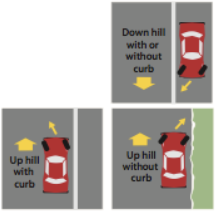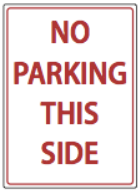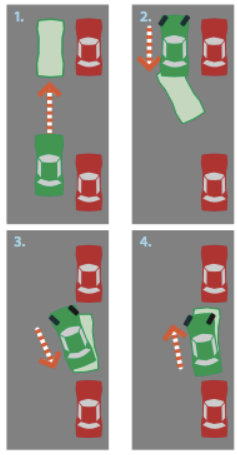Session 17 – Parking
PARKING
You are responsible for making sure your vehicle is not a hazard when it is parked. Whenever you park, be sure it is in a place far enough from any travel lane to avoid interfering with traffic and that is visible to vehicles approaching from either direction.
- Park in a designated parking area if possible.
- Always set your parking brake when you park. Leave the vehicle in the lowest gear if it has a manual transmission, or in “park” if it has an automatic transmission.
- A possible exception to this is during cold weather when it is possible the parking brake could freeze in the “on” position. At such times, you may choose to leave the parking brake off. Your vehicle should still be left in the lowest gear or in “park”.
- If parked on a rural highway, you must leave at least 15 feet of road width for other traffic to pass your vehicle. Your vehicle must be visible for at least 500 feet in either direction. Your parking lights and taillights must be on if it is dark outside.
- Get out of the vehicle on the curb side if you can. If you have to use the street side, check traffic before you open
the door. Shut the door as soon as you can after getting out. - Never leave the ignition key in a parked vehicle. It is a good habit to lock the doors whenever you leave your vehicle.
- If you must park on a roadway, park your vehicle as far away from traffic as possible. If there is a curb, park as close to it as you can.
How to Park on a Hill
- Check for traffic in your mirrors and blind spot. Signal right. Pull over as far right as possible and stop. Slow as you are moving out of traffic.
- Turn your wheels sharply to the left if there is a curb and you face uphill.
- Turn your wheels sharply to the right if there is no curb or if you face downhill. See the illustrations. This way, if your vehicle starts to roll, it will roll away from traffic.
- Set your emergency brake and place your vehicle in park. If your vehicle has manual transmission, shift into reverse if parking downhill or into the lowest gear if parking uphill.
- To resume travel, put your turn signal on, check mirrors and blind spot. When safe, pull out into your traffic lane.

Do Not Park

- in an intersection
- in a construction area if your vehicle will block traffic
- within 15 feet of a crosswalk or intersection
- within 10 feet of a fire hydrant
- within 25 feet of a railroad crossing
- more than one foot from the curb
- within 15 feet of a fire station driveway on the same side of the street or directly across from the entrance
- within 4 feet of a driveway, alley, or private road, or blocking the area of the curb removed or lowered for access to the sidewalk
- in front of a school (grades K–eight) from 7:30 a.m. to 4:30 p.m. on school days, or as posted
- on a bridge or overpass, or in a tunnel or underpass
- on the wrong side of the street (opposing traffic)
- in a space marked for the disabled, unless you have a special parking permit or plates for the disabled
- on the road side of a parked vehicle (double parking)
- on railroad tracks
- wherever a sign says you cannot park.
How to Parallel Park
(Observe other traffic, pedestrians and fixed objects throughout these steps.)
1. Check traffic in rear-view mirrors as you slow. Put your turn signal on. Stop even with the vehicle ahead and about 2 feet away from it.
2. Turn wheels right and slowly back toward the vehicle behind. As the front door passes the back bumper of the vehicle ahead, straighten the wheels and continue to back straight.
3. When clear of the vehicle ahead, turn wheels sharply left and back slowly to the vehicle behind. Be looking to the sidewalk area and towards the vehicle behind you.
4. Turn wheels right and pull toward the center of the parking space. Straighten wheels unless you are on a hill. When the maneuver is finished, your vehicle should be within 12 inches of the curb or edge of the road, and at least 2 feet away from parked vehicles.

To resume travel, put your turn signal on, check mirrors and blind spot. When safe, pull out into your traffic lane.
